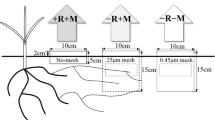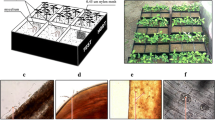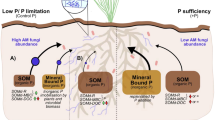Abstract
Background and aims
Arbuscular mycorrhizal (AM) hyphae represent an important route for input of plant-derived C to soil, but impacts of these inputs on microbial communities and processes are poorly understood. In this study we characterised pathways of C-flow through microbial communities associated with AM hyphae and quantified impacts on mineralisation of native SOM.
Methods
Continuous, steady-state 13CO2 labelling was applied throughout the growth period (60 d) of Lolium perenne. Exclusion meshes were used to control access of roots and AM hyphae to soil, and plant-derived C was quantified within microbial PLFA and NLFA, and soil CO2 efflux was partitioned into plant- and soil organic matter (SOM) derived components.
Results
Pathways of C-flow through hyphosphere and mycorrhizosphere communities were distinct, as was the fate of plant-derived C from AM hyphae accessing soil through 37 and 1 μm meshes. Mineralisation of native SOM was increased in all treatments, relative to unplanted controls, and this priming effect was largest for AM hyphae accessing soil through the 1 μm mesh size.
Conclusions
We demonstrated that AM hyphae can strongly increase mineralisation of native SOM and identified distinct pathways of C-flow through hyphosphere communities. Our results suggest that, in addition to affecting rates of litter decomposition, AM hyphae may have a significant influence on turnover of native SOM.


Similar content being viewed by others
References
Andrade G, Mihara KL, Linderman RG, Bethlenfalvay GJ (1997) Bacteria from rhizosphere and hyphosphere soils of different arbuscular-mycorrhizal fungi. Plant Soil 192:71–79
Averill C, Turner BL, Finzi AC (2014) Mycorrhiza-mediated competition between plants and decomposers drives soil carbon storage. Nature 505:543–545
Balser TC, Treseder KK, Ekenler M (2005) Using lipid analysis and hyphal length to quantify AM and saprotrophic fungal abundance along a chronosequence. Soil Biol Biochem 37:601–604
Bååth E (2003) The use of neutral lipid fatty acids to indicate the physiological conditions of soil fungi. Microbial Ecol 45:373–383
Bender SF, PLantenga F, Neftel A, Jocher M, Oberholzer HR, Kohl L, Giles M, Daniell TJ, van der Heijden MGA (2014) Symbiotic relationships between soil fungi and plants reduce N2O emissions from soil. ISME J 8:1336–1345
Bligh EG, Dyer WJ (1959) A rapid method of total lipid extraction and purification. Can J Biochemical Physiol 37:911–917
Bodeker IT, Clemmensen KE, de Boer W, Martin F, Olson A, Lindahl BD (2014) Ectomycorrhizal Cortinarius species participate in enzymic oxidation of humus in northern forest ecosystems. New Phytol 203:245–256
Cheng W, Johnson DW, Fu S (2003) Rhizosphere effects on decomposition: controls of plant species, phenology, and fertilization. Soil Sci Soc Am J 67:1418–1427
Cheng L, Booker FL, Tu C, Burkey KO, Zhou L, Shaw HD, Rufty TW, Hu S (2012) Arbuscular mycorrhizal fungi increase organic carbon decomposition under elevated CO2. Science 337:1084–1087
De Graaff M-A, van Kessel C, Six J (2009) Rhizodeposition-induced decomposition increases N availability to wild and cultivated wheat genotypes under elevated CO2. Soil Biol Biochem 41:1094–1103
Fitter AH, Helgason T, Hodge A (2011) Nutritional exchanges in the arbuscular mycorrhizal symbiosis: implications for sustainable agriculture. Fungal Biol Rev 25:68–72
Fontaine S, Mariotti A, Abbadie L (2003) The priming effect of organic matter: a question of microbial competition? Soil Biol Biochem 35:837–843
Fontaine S, Barot S, Barre P, Bdioui N, Mary B, Rumpel C (2007) Stability of organic carbon in deep soil layers controlled by fresh carbon supply. Nature 450:277–280
Garcia-Pausas J, Paterson E (2011) Microbial community abundance and structure are determinants of soil organic matter mineralisation in the presence of labile carbon. Soil Biol Biochem 43:1705–1763
Glentworth R, Muir JW (1963) The Soils of the Country Round Aberdeen, Inverurie and Fraserburgh. HMSO, Macaulay Institute of Soil Research. Mem Soil Survey of Great Britain. Edinburgh
Hanson JR, Macalady JL, Harris D, Scow KM (1999) Linking toluene degradation with specific microbial populations in soil. Appl Environ Microbiol 65:5403–5408
Heinemeyer A, Ineson P, Ostle N, Fitter AH (2006) Respiration of the external mycelium in the arbuscular mycorrhizal symbiosis shows strong dependence on recent photosynthates and acclimation to temperature. New Phytol 171:159–170
Herman DJ, Firestone MK, Nuccio E, Hodge A (2012) Interactions between an arbuscular mycorrhizal fungus and a soil microbial community mediating litter decomposition. FEMS Microbiol Ecol 80:236–247
Ho I, Trappe JM (1973) Translocation of 14C from Festuca plants to their endomycorrhizal fungi. Nature 244:30–31
Hodge A, Fitter AH (2010) Substantial nitrogen acquisition by arbuscular mycorrhizal fungi from organic material has implications for N-cycling. PNAS 107:13754–13759
Hodge A, Campbell CD, Fitter AH (2001) An arbuscular mycorrhizal fungus accelerates decomposition and acquires nitrogen directly from organic material. Nature 413:297–299
Izumi H, Elfstrand M, Fransson P (2013) Suillus mycelia under elevated atmospheric CO2 support increased bacterial communities and scarce nifH activity in contrast to Hebeloma mycelia. Mycorrhiza 23:155–165
Jansa J, Bakovska P, Gryndler M (2013) Mycorrhizal hyphae as ecological niche for highly specialised hypersymbionts – or just soil free-riders? Frontiers Plant Sci 4:article 134
Kaiser C, Kilburn MR, Clode PL, Fuchslueger L, Koranda M, Cliff JB, Solaiman ZM, Murphy DV (2015) Exploring the transfer of recent photosynthates to soil microbes: mycorrhizal pathway vs direct root exudation. New Phytol 205:1537–1551
Klamer M, Bååth E (2004) Estimation of conversion factors for fungal biomass determination in compost using ergosterol and PLFA 18:2ω6,9. Soil Biol Biochem 36:57–65
Koller R, Rodriguez A, Robin C, Scheu S, Bonkowski M (2013) Protozoa enhance foraging efficiency of arbuscular mycorrhizal fungi for mineral nitrogen from organic matter in soil to the benefit of host plants. New Phytol 199:203–211
Kuzyakov Y (2010) Priming effects: interactions between living and dead organic matter. Soil Biol Biochem 42:1363–1371
Lee J, Lee S, Young JPW (2008) Improved PCR primers for the detection and identification of arbuscular mycorrhizal fungi. FEMS Microbiol Ecol 65:339–349
Leigh J, Fitter AH, Hodge A (2011) Growth and symbiotic effectiveness of an arbuscular mycorrhizal fungus in organic matter in competition with soil bacteria. FEMS Microbiol Ecol 76:428–438
Murphy CJ, Baggs EM, Morley N, Wall DP, Paterson E (2015) Rhizosphere priming can promote mobilisation of N-rich compounds from soil organic matter. Soil Biol Biochem 81:236–243
Nilsson LO, Giesler R, Bååth E, Wallander H (2005) Growth and biomass of mycorrhizal mycelia in coniferous forests along short natural nutrient gradients. New Phytol 165:613–622
Olsson PA, van Aaarle IM, Gavito ME, Bengtson P, Bengtsson G (2005) 13C incorporation into signature fatty acids as an assay for carbon allocation in arbuscular mycorrhizal. Appl Environ Microbiol 71:2592–2599
Paterson E (2003) Importance of rhizodeposition in the coupling of plant and microbial productivity. Eur J Soil Sci 54:741–750
Paterson E, Sim A (2013) Soil-specific response functions of organic matter mineralisation to the availability of labile carbon. Glob Change Biol 19:1562–1571
Paterson E, Thornton B, Midwood AJ, Sim A (2005) Defoliation alters the relative contributions of recent and non-recent assimilate to root exudation from Festuca rubra. Plant Cell Environ 28:1525–1533
Paterson E, Gebbing T, Abel C, Sim A, Telfer G (2007) Rhizodeposition shapes rhizosphere microbial community structure in organic soil. New Phytol 173:600–610
Paterson E, Thornton B, Midwood AJ, Osborne SM, Sim A, Millard P (2008) Atmospheric CO2 enrichment and nutrient additions to planted soil increase mineralisation of soil organic matter, but do not alter microbial utilisation of plant- and soil C-sources. Soil Biol Biochem 40:2434–2440
Paterson E, Midwood AJ, Millard P (2009) Through the eye of the needle: a review of isotope approaches to quantify microbial processes mediating soil carbon balance. New Phytol 184:19–33
Paterson E, Neilson R, Midwood AJ, Osborne SM, Sim A, Thornton B, Millard P (2011) Altered food web structure and C-flux pathways associated with mineralisation of organic amendments to agricultural soil. Appl Soil Ecol 48:107–116
Rillig MC, Mummey DL, Ramsey PW, Klironomos JN, Gannon JE (2006) Phylogeny of arbuscular mycorrhizal fungi predicts community composition of symbiosis-associated bacteria. FEMS Microbiol Ecol 57:389–395
Scheublin TR, Sanders IR, Keel C, van der Meer JR (2010) Characterisation of microbial communities colonising the hyphal surfaces of arbuscular mycorrhizal fungi. ISME J 4:752–763
Staddon PL, Robinson D, Graves JD, Fitter AH (1999) The δ13C signature of the external phase of a Glomus mycorrhizal fungus: determination and implications. Soil Biol Biochem 31:1067–1070
Staddon PL, Brook Ramsey C, Ostle N, Ineson P, Fitter AH (2003) Rapid turnover of hyphae of mycorrhizal fungi determined by AMS microanalysis of 14C. Science 300:1138–1140
Sun YP, Unestam T, Lucas SD, Johanson KJ, Kenne L, Finlay R (1999) Exudation-reabsorption in a mycorrhizal fungus, the dynamic interface for interaction with soil and soil microorganisms. Mycorrhiza 9:137–144
Sylvia DM (1986) Spatial and temporal distribution of vesicular-arbuscular mycorrhizal fungi associated with Uniola paniculatum in Florida foredunes. Mycologia 5:728–734
Talbot JM, Allison SD, Treseder KK (2008) Decomposers in disguise: mycorrhizal fungi as regulators of soil C-dynamics in ecosystems under global change. Func Ecol 22:955–963
Toljander JF, Artursson V, Paul LR, Jansson JK, Finlay RD (2006) Attachment of different soil bacteria to arbuscular mycorrhizal extraradical hyphae is determined by hyphal vitality and fungal species. FEMS Microbiol Lett 254:34–40
Uibopuu A, Moora M, Saks U, Daniell TJ, Zobel M, Öpik M (2009) Differential effect of arbuscular mycorrhizal fungi communities ecosystems along a management gradient on the growth of forest understory plant species. Soil Biol Biochem 41:2141–2146
Van Aarle I, Olsson PA (2003) Fungal lipid accumulation and development of mycelial structures by two arbuscular mycorrhizal fungi. Appl Environ Microbiol 69:6762–6767
Van Hees PAW, Johansson E, Jones DL (2008) Dynamics of simple carbon compounds in two forest soils as revealed by solution concentrations and biodegradation kinetics. Plant Soil 310:11–23
Veresoglou SD, Chen B, Rillig MC (2012) Arbuscular mycorrhizal and soil nitrogen cycling. Soil Biol Biochem 46:53–62
White DC, Davies WM, Nickels JS, King JC, Bobbie RJ (1979) Determination of sedimentary microbial biomass by extractable lipid phosphate. Oecologia 40:51–62
Whiteside MD, Digman MA, Gratton E, Treseder KK (2012) Organic nitrogen uptake by arbuscular mycorrhizal fungi in a boreal forest. Soil Biol Biochem 55:7–13
Zelles L (1999) Fatty acid patterns of phosphplipids and lipopolysaccharides in the characterisation of microbial communities in soil: a review. Biol Fertil Soil 29:111–129
Zhu B, Cheng W (2011) Rhizosphere priming effect increases the temperature sensitivity of soil organic matter decomposition. Glob Change Biol 17:2172–2183
Acknowledgments
We are grateful to Nia Gray for PLFA and NLFA extractions, to Barry Thornton and Maureen Procee for their expertise in 13C compound-specific analyses and to Shona Osborne for support in maintenance of the experiments. We would also like to thank Tim George for comments on an earlier version of the text, and two reviewers for their suggestions to improve the manuscript. The research was funded by the Rural and Environmental Science and Analytical Services (RESAS) division of the Scottish Government.
Author information
Authors and Affiliations
Corresponding author
Additional information
Responsible Editor: Thom W. Kuyper.
Electronic Supplementary Material
ESM 1
Figure S1 Photograph illustrating the microcosm systems, and on the right hand side, separately, an exclusion cores with syringe barrel fitted for collection of soil CO2 efflux. (JPEG 1669 kb) (JPEG 1.62 mb)
Rights and permissions
About this article
Cite this article
Paterson, E., Sim, A., Davidson, J. et al. Arbuscular mycorrhizal hyphae promote priming of native soil organic matter mineralisation. Plant Soil 408, 243–254 (2016). https://doi.org/10.1007/s11104-016-2928-8
Received:
Accepted:
Published:
Issue Date:
DOI: https://doi.org/10.1007/s11104-016-2928-8




